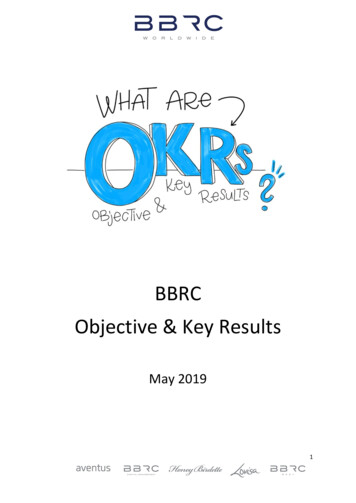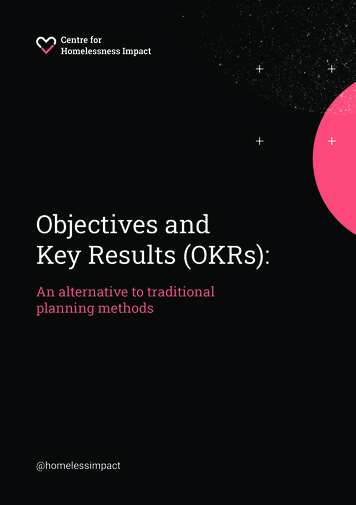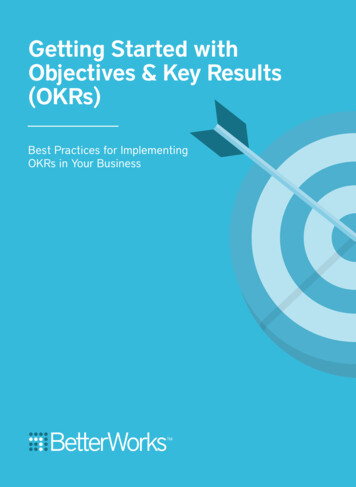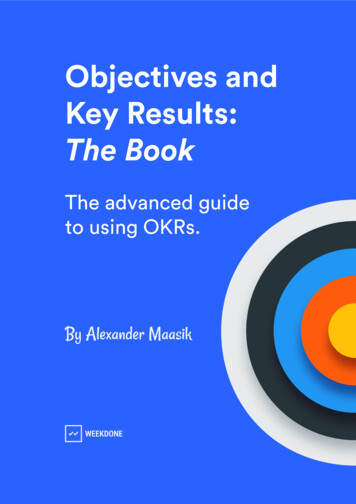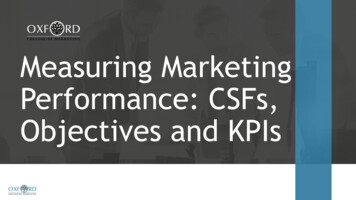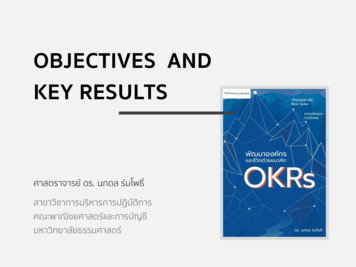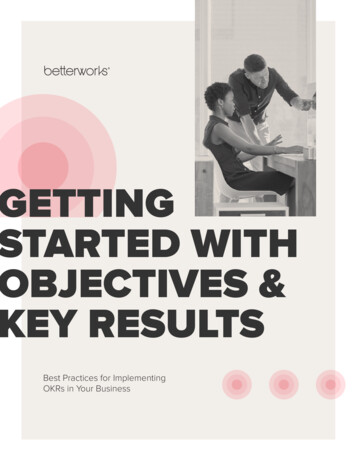
Transcription
Pacific Business Review InternationalVolume 13 issue 9 March 2021Objectives and Key Results for Higher Educational Institutions– A BlendedApproachas Part of Post Covid-19 Initiatives for Keeping the InstitutionsAbreast of the Industry Innovations, Create Future Leaders and Build the NationDr. Mruthyanjaya Rao MangipudiAbstractHead, Academics & Industry Partnerships,IIHRD, HyderabadThere is an urgent need that the Higher Educational Institutescontinuously enhance and advance its systems, in particular, whilstevaluating the performance in its entirety. There is a disproportionateupsurge in costs for providing excellent education however, there is aserious mismatch between the costs incurred and students'expectations as well as the industry. The orthodox and traditionalmodel of appraising does not help the institutions or universities tomeet the dynamic requirements of the business. It is essential that theHigher Education Institutionsalso develop a new-age performancemanagement system similar to the industry to evaluate the availableresources and assess the performance. The researchers here presentperformance management system Objectives and key results toabstract design and apply robust assessment strategies to test theperformance of an institution, the faculty, the learning community, andother stakeholders or team involved in the system to align theobjectives collectively to achieve the desired goal. Primarily, three andfour objectives can be set up with four to five key results, in order, tosignify each of the objectives. The Objectives and keyresultsframework can be set up at several levels – Individual,department, and Institution levels. The framework presented willenhance the efficacy of the institute and improves engagement,interpersonal relations, engagement at all levels, accountability, andcultural visibility. The suggested framework is believed to be not onlyimproving the efficiency of the institution but also enhancescommunication, engagement, accountability, interpersonal relations,and cultural prospects.Dr. KDV PrasadAdjunct Professor,IIHRD, Senior Officer, ICRISAT, Patancheru,HyderabadDr. Rajesh W. VaidyaAssistant Professor,Shri Ramdeobaba College of Engineering andManagement, Nagpur, IndiaKeywords: Objectives and Key Results, Higher Education,Institutions, Universities, Post Covid-19 initiatives by HEIsIntroductionThe 'search' for the reason for a gap among academia and the industryalways seems to be ending with pointing fingers at each other without athorough 'research' and understanding the actual challenges. Theauthors delve into the study, explored various reasons, and the need forbridging the gap between these two imperative constituents in societyto build a better nation. The authors found out two differentperspectives about educational institutions and the industry. Theestablishments of higher institutions have a perception of predominantsubjective learning and know-how of a variety of cultures, attitudes,aspirations of the people, gain knowledge in the areas of interest at46www.pbr.co.in
Pacific Business Review Internationallearner per according to their learning abilities and theneeds. The educational institutions such as colleges,universities, business schools are being expected to sharethe knowledge to the fullest extent and in-depth in therespective subjects, and in the process, more branches ofstudy viz., Engineering, Fine Arts, Social Sciences,Humanities, Business Management, etc., have emergedwith specializations again in each of these areas. Thereforeviewpoint concerning higher educational institutesisconcerned, by and large, is that the HEIs are onlyknowledge dispensaries and persist under the category ofnon-profit entities. Whereas the expectations from theseinstitutions are enormous and they are believed in such away that they do not deliver what the industry requires. Onthe other hand, globalization, the standards of living ofpeople, changes in the socio, legal, economic, politicalcultures, and privatization of public sector units includingthe education sectors threw a challenge to the organizationsto deliver according to the changing business landscapeswith a commercial, business and profit motive (Bakhtiari&Shajar, 2006). Thus, there exists a gap, and the divide iswide between the educational institutions and thecommercial organizations. Eventually, it is evident that,with the establishment of business schools andtechnological premium institutions, the gap is now slowlynarrowing for the reason the objectivity is realized. Hence,the apparent reason could be more or less the differencebetween subjectivity versus objectivity.Today'sorganizations operate in a tough competitive space withobjectivism in mind where the objective is to satisfy thebusiness needs of the organizations and to enhance thevalue of the stakeholders on one hand and deliver the bestservice or solutions to the satisfaction of the customers. It ishighly impractical to assume that the human resources inthe organization shall carry and continue with the samespirit as they are in the educational institutions (Broekkamp& Bernadette van Hout-Wolter, 2007). In the currentscenario, the tole any student is moving a from just learnerand knowledge attainer to the implementer of theknowledge gained in the industry once placed withindustry. So is the case with the students or learnersexpecting them to switch their frame of mind and approachimmediately towards objectivism as soon as they join abusiness entity or commercial organization?Review of LiteraturePerformance Management Systems in HEIs: In HigherEducational Institutions or Universities, there does notseem to be a wing to oversee and measure the performanceand evaluate the impact of the outcome. In Europe, and inthe United States of America, several Institutions areslowly adapting to the innovative performancewww.pbr.co.inmanagement systems to bring necessary reforms (Arbo,2008). It is evident through the second study that theauthors made that the periodic accreditation activities bythe Universities are inadequate, and they do not meet theever-changing business requirements at both national andinternational levels, and they fail to play an effective role. Itis therefore recommended to implement a PMS thatmonitors the inputs, processes, and outputs in such a waythat it improves the performance of the institution andstrive towards improving the urgent developmental needsof the country.Salau et al., (2020)in their study applying structuralequational modeling, on a data set of 384 academic staff onretention outcomes of public universities in south Nigeriareported inadequate and obsolete infrastructure is the mainreason for retention and impact of workplaceenvironments. This study further reported disparities instudent-teacher ratio, promotion policies, congestedclassrooms are significantly influencing the retentionoutcomes. Decramer et al. (2013) revealed in their study onperformance management culture system and itsrelationship with employee performance managementsatisfaction in survey y with 589 employees of FlemishUniversity, Brussels, reveal enhanced communication withinternal consistencies among the employees andmanagement, associated with performance managementsatisfaction of academic employees (Adelien Decramer,2013). Awanand Karim (2018), reported how they couldbring the required change through the implementation ofPMS European University, and they also reminded thatthere exists PMS in Higher Educational Institutions butneeds tremendous improvement to suit the industryrequirements, and the authors strongly recommended thenecessity of having a mechanism to improve theperformance and align the goals of the learningcommunity, faculty and the universities/institutions.Achem Krausert commented in his paper published in ajournal, Human Resources Management Review, that PMSquantifies the performance in numbers and let themanagement know how well a resource has beenperforming comparatively in an organization/institution,and that is important (Krausert, 2017)Key factors of PMS in HEIs: The authors identified certainkey factors based on the necessities of the new ageuniversities, deemed-to-be-universities, autonomousinstitutions. Industry-oriented multi-disciplinary research,learning by doing projects, diverse culture in vibrantcampus, methodologies based student aspirations, makingstudents related industry-ready for the holisticdevelopment of a student, sessions for interpersonal skills,industry-oriented innovative curriculum, regular47
Volume 13 issue 9 March 2021internship, and placement programs, engagingdistinguished faculty including the guest faculty or adjunctfaculty from the industry in the respectivedomains/education field, ICT enabled learning, etc., aresome of the significant factors that help institutes as wellindustry. If a PMS is designed through developing OKRsconsidering the above-mentioned factors, with the requiredmodifications that suit the respective institutions, and thevolatile industry environment, the academic must pursuethe strategies to a limited gap between the industry and(Mathew, 2020).During the pandemic situations like theCovid-19, the contactless sessions such as the ICT(Information and Communication Technology) enabledlearning gives much respite to the learning community.With Governments across the world, including India givesmuch importance to Digitalization, the delivery ofinformation/lessons through ICT would be the best modeof delivery of education even to reach unreachable (Team,2017). In addition to the above, it is pertinent to note thatthe institutions should have to take into consideration the“Sixas” as to remain competitive and relevant in the race,and they are - Actualize, Adaptive, Agile, Align, Analytical,Automate that facilitate the possibilities to enhance thevalue of each process or method under OKRs and improvesperformance in total, within the Institution in conformitywith its objectives (Mruthyanjaya Rao & Prasad,2020).Boniface Niyivuga et al., (2019) suggested thepolicymakers to design a policy to assess the performanceof higher education staff, studying the association amongmonitoring and evaluation practices and motivation ofRwandan higher education staff. The authors concludedthat peer evaluation and active participation of academicstaff are essential for continuous improvement and the staffis motivated with autonomy, overwork recognition.Camilleri & Camilleri (2018), suggested that academicinstitutions should evaluate the performance outcomesroutinely and outcomes need to be monitored to visualizethat the academicians are optimally managing theresources and capacities using and the authors suggestedthe use of HRM systems.Ning Zhou et al., (2009) reported amulity-layer, service-oriented architechture andimplemented the sameconcerning framework with digitalcampus for higher education systems. Micahel Moody(2019) suggested Streamline and implementtools flexibly,Design systems as a formative feedback process, Supportevaluators to be coaches, more people involvement, Use ofvideo tools to focus on meaningful feedback to improve theperformance system of the facultyand ensure qualityteaching an opportunity for growth.Problem StatementGiven the background as narrated above, the objectivism48shall start with the educational institutions, too. Theindustry is clear in what they require, and it is apparent thatthey require resources that contribute to the business fromday one. Why the institutes doest not adopt a method fortheir faculty? The assumption is that the that an instituteorganization offer services, solution, and end products tothe consumers and creating an economical value to theorganizations. Therefore, the HEIs should start assessingthe available systems, human and financial resources, andmethodologies similar to the industry. In the presentsystem, there is an urgent need to transform the teachingmethods to be related to outcome-based education.Therefore, why can't a PMSassess and measure theteaching fraternity which is the catalyst for delivering theeducation to the students? The authors, therefore, tried tofind out a rationale behind introducing Objectives and KeyResults to assess the performance of the teaching faculty byan independent unit within the university/college/institution to maximize the efficiency of not only theinstitution but also to gauge the students' ability to learn andunderstand what they are taught and measure the impact ofsuch framework at a later stage.Aims and ObjectivesWith the introduction of OKRs in the educationalinstitutions, some of the following key elements andobjectives can be achieved, and make use of the newsystem to meet the industry and Nation demands and in therace. OKRs may be framed to achieve the followingobjectives which are indicative but not exhaustive:To measure the students gain the strategies and insightsthrough tools, case studies, lectures, simulations, groupdiscussions to dissect the challenging real-world issuesTo understand how the learners apply what they studied tothe situations in the organizations and showcase higherlevels of leadership, launch new products, ventures, andenhance operational improvements.Developed Center of Excellence to develop the globalbusiness approach and student participation throughexchange programs and research hubs within and outsideoutsideTo developed collaborations and student diversity in theinstitutions for adaptabilityTo strengthen networking opportunities with advancedresearch institutes and organizations across the world forcollaboration, interaction, and student exchange programTo enable students on continuous learning through criticalthinking and practical applications and enabling industryoriented research.www.pbr.co.in
Pacific Business Review InternationalResearch QuestionsThe following questions arise during the study. Theyare:How does the PMS narrow the space between andacademic contributions to the institutions' success?What are the OKRs and how have OKRs been designed tohelp the institutions to measure faculty performancecontinuously?How do the OKRs pave the way for theinstitutions/universities/colleges in measuring the impactin the future and continually?Significance of the studyThe most needed and challenging aspect of academia is tofind out mechanisms to narrow the gap and sail along withthe industry, and, more importantly maintaining the coreideology of an education system to create a vibrantknowledge society by providing high-quality education,develop an inclination towards values and ethics,commitment to human rights and global well-being(LinkedIn, 2020). It has to strike the right balance betweenits core educational principles and stakeholders' businessvalue proposition. That is the crux for maintainingacademia-industry linkage and the academic instituteshould be ahead of industry for imparting education, withbusiness simulations as part of student education strategiesto make them industry and nation ready. The performancemanagement system, should consider all these factors,identify or whatever name that one could give it to it, it isnecessary for the institutions and establishesanindependent unit within its system for carrying out a thirdparty evaluation.Establishment of a strategic unit to evaluate theperformanceUsually, the institutions have collegiate academic bodiesthat lack autonomy over certain aspects of performancemanagement or talent management (Baporikar, 2019).These bodies operate following the State or CentralGovernment or national level regulatory bodies. ForExample, in India, the University Grants Commission(UGC). There are also certain accreditation bodies andassessing agencies such as the National Board ofAccreditation (NBA), established by the All India Councilof Technical Education (AICTE) for ensuring quality andrelevance to technical education; National Assessment andAccreditation Council (NAAC) an autonomous institutionof UGC for making quality assurance an integral part of thefunctioning of Higher Education Institutions (HEIs).Certain Key Indicators (KIs) have been identified bywww.pbr.co.inNAAC for the criteria set by it for each of the significantareas pertain to the dispensation of education, and each ofthose indicators carries stipulated weightage distributed forall the universities, autonomous colleges, affiliated andconstituent colleges. Out of all, under the criteria by name,“Teaching-Learning and Evaluation”, the weightagedistributed for the key indicator, “Evaluation process andreforms” is only 40/200. One could assume the importancethat has been given to “evaluation process and reforms”,which is 20 percent in the subject case. It must beappropriate at the NAAC level to distribute only 20 percentof importance out of 200 points to the evaluation processand reforms.However, it is for the Universities,Autonomous Colleges, and the affiliated/constituentcolleges to devise the ways and means and design theappropriate methodology as to how do they oversee theoverall performance of their university or institution.Therefore, it is necessary to establish a separate strategicunit within the campus, preferably, Human ResourcesDepartment, and delegate this responsibility of facilitatingthe performance management system and also designingthe objectives and key results (OKRs) for every aspect thatNAAC, NBA, UGC and AICTE touched upon. The authorslisted some of the OKRs vide Annexure that does seem tobe of greater importance for the benefit of theInstitutions/Universities National Policy Board forEducational Administration. New York: NPBEA (Va,2015), and Department of Education, Institute ofEducation Sciences, NCEERA (Washington DC, 2015)LimitationsThe study is majorly focused upon the industries with aprofit motive or commercial objectives. The rationalebehind this study is to bridge the gap between academia andindustry and the ways and means of how this gap can benarrowed through a mechanism and to identify the lapses,deficiencies of thoughts and beliefs and the reasons for theinstitutions being deprived of this consideration by most ofthe people who hold the faculty and the educationalinstitutions responsible for these gaps. Of course, thisstudy may not be applicable for the situations where the'aim and objective' is to 'study and gain knowledge' in thesaid educational institutions or universities only to 'impartsimilar knowledge' in another university or college, for thereason there does not exist any application of knowledge tothe satisfaction of industry or there does not exist anyelement of business advantage.Research GapMost of the surveys, reports, studies have been conductedby various eminent researchers across the world includingin India based on what could be done through PMS and how49
Volume 13 issue 9 March 2021it acts on the well being of academic employees and highereducation institutions, and how do they perceive the PMSand its impact on employees. Even, the Governmentagencies and regulatory bodies in India such as UGC,AICTE, NAAC, NBA, and the elders emphasize thedispensation of qualitative education but do not givespecific attention to the evaluation of the performance ofthe faculty and the administrators of an institution/university through PMS. The authors could see a gap insuch research as to how do we bridge the gap between theindustry and academia, and how does an effective PMSthrough designing OKRs could help overcome thedifficulty of bridging the gap and ensure better synergy, acollaboration between both the significant constituents innation-building.Data Collection:A research methodology is a procedure used toscientifically perform a research study. The methodologypermits the reader to significantly assess the article'soverall authenticity and consistency. There are twoquestions answered by the authors here, and they are – howhas been the data collected or gathered by the researcher?How was the data investigated to arrive at conclusions?The research paradigm for this study is by applyingpractical tribulations being faced by the institutions and theorganizations, and by close observation of these twoconstituents in the ecosystem of higher education andlearning space. The researchers collected all the relevantdata and information validly and reliably via a qualitativeresearch approach, which is subjective and inductive.Content analysis has been done extensively using thewebsite of universities, regulatory bodies, autonomousinstitutions' websites, etc. As far as surveys are concerned,the researchers used the surveys which have already beenconducted by the research scholars for the subject understudy. The authors are satisfied that the results through thesurveys conducted by external agencies are sufficientenough to support the study. Extensive exploration wasconducted by going through ethnographies, history, casestudies, newsletters, and sufficient documents and modelswere observed to acquire more knowledge andinformation. Thus, the researcher used and dependedmostly on secondary data.Data Analysis:The authors applied some of the relevant statisticalprocedures and methods, such as descriptive, exploratory,50Research Hypothesis1.PMS bridges the gap between academia and industry andcontributes to the success of the institution.2.The OKRs help the institutions assess the performance ofthe faculty continuously.Research MethodologyThe Framework is based on the model based on Yoon et al.,2007 (Figure 1), a three-step framework whereAcademician's qualification and learning enhance his/herknowledge and skills, enhanced improved teaching andimproved teaching raises student achievement. Based onthis the following model was developed.inferential, and predictive types which are found to bespecific and helpful for this study (Khan et al. (2015). Thethematic presentation of data is done by emphasizingpinpointing, evaluating, recording different patterns ofdata (Khan et al. 2017). The research has also beenconducted by applying Diagnostic analytics,PredictiveAnalytics, and Prescriptive analytics to devisethe framework to suit the objectives of the study. Thathelped the researchers to get better learning andunderstanding of the causes of situations, events, andnecessities for the institutions to adopt the best waypossible to get closer to the industry. It also helped theauthors to recognize the best opportunities for theinstitutions and universities through framing a robust PMSusing OKRs. The use of descriptive methods helped theauthors to acquire simple summaries.The dataaggregation and data mining areas equivalent as possiblefor a study conducted under quantitative as they used thesurveys conducted by the predecessors.After having analyzed the data and information available atthe disposal of the researchers/authors, the researchersfound justifications and the solutions to the setbacks, andthus, they could answer the following research questions asfollows:(i) How does the PMS bridge the gap betweenacademia and industry and contribute to theinstitutions' success?Unless the higher institutions of learning follow what theindustry follows and requires, and implement themethodologies, and use the same scale similar to what anorganization does in assessing the performance of theirwww.pbr.co.in
Pacific Business Review Internationalresources, the institutions cannot achieve the objective ofbridging the gap, and it remains as an illusion as long asthey use a different scale in measuring the performance. Atthe same time, one would say that everything will fall inline automatically and happens on its own in achieving theinstitutional goals if a PMS is implemented without givingthe required importance and gone a rigorous thoughtprocess into it. There must be an alignment of goals, andthe goals must be defined in a crystal clear manner. Forexample, implementation of ICT is a goal for which shallbe considered all aspects that are helpful to achieve ICTgoals. Quality of resources, regular assessment, gettingupdated with the online teaching tools available for betterdispensation of classes/coaching. So is the innovativepedagogy. When innovation occurs, quality checks mustbe followed to fructify the results achieved out of the saidobjective.Further, PMS can be a catalyst to devise the objectives andgoals according to the industry requirements, and theremust be a continuous collaboration between these two. Forexample, for an IT company, a programming language,called Angular JS version 8 is required, whereas, theinstitution is imparting Angular basic version or Javaprogramming language, which is not helpful and is notwww.pbr.co.insyncing with the requirements. Here, through PMS, one ofthe objectives could be devised exactly to match therequirement to measure the said objective later if anydeviation occurs. Even at the least, they will be able toknow the reason where the gap is. Hence, PMS is anessential tool for educational institutions to get their goalsaligned in every aspect.(ii) What are the OKRs and how have OKRs beendesigned to help the institutions assess the performanceof the faculty continuously?After the identification and categorization of objectivesaccording to the institution's vision and mission, each ofthese goals should have measurable key results in terms ofnumbers. All parameters, criteria, indicators, and metricsthat the evaluator would assess shall be converted tonumbers to easily identify and track the progress that isbeing made from time to time. The following table explainswhat are the OKRs (Objectives and Key Results) and howhave they been given weightage. The table and the OKRsand the weightage are only indicative figures and numbers,and the actual OKRs can be varied based on the importancethat they would like to assign to each of these OKRs.51
Volume 13 issue 9 March 202152www.pbr.co.in
Pacific Business Review InternationalTable-1 above shows how the OKRs can be designed at anindividual level i.e., the goals for each faculty, dependingon the department, unit in which s/he works. There is norigid rule or compulsion that the objectives must be writtenonly in a particular way. However, each and every goalmust be aligned with the desired outcomes. Keeping theoutcomes/results in view, the goals must be identified andcategorized. Any deviation or wrong perception about thevision and mission of the University/College/Institutionwill result in that way. It simply follows the input process output model. The more quality of the inputsthat are keying in, the higher will be the quality of outputsthat are coming out.(iii) How do the OKRs pave the way for theinstitutions/universities/colleges in measuring theimpact in the future and continually?Once the institution has the mechanism in place, it takescare of the evaluation at every stage. As the process iscontinuous, the results will be visible and obvious as itwww.pbr.co.inruns. The progress can be viewed through dashboards on areal-time basis. For example, at an institutional level, 6patents have to be developed over an academic year, andthe institution could achieve only 3, the progress in thedashboard displays as 50% of the objective is achieved sofar, and it is known where does the institution stand as far as'Patent' objective is concerned. So are the other objectives,key results, and their respective progress. This mechanismenables the institution and the individuals (who are facultymembers in this case) to save time, effort, and energy, asthey need not wait till NAAC or NBA visit and then give areport stating that they complied with the norms or not.The same accreditation rules or criteria can become theobjectives and key results for the PMS of an Institution, andthe progress can be monitored on a real-time basis, andnecessary modifications or change in the processes,systems, and pedagogies can be made so as to be on trackand achieve the desired result. That is how the HEIs(Higher Educational Institutions of learning) can measurethe impact continuously.53
Volume 13 issue 9 March 2021The thematic diagram above represents the OKRs in PMSfor Higher Educational Institutions and how the objectivescan be categorized into six areas, i.e, academics, researchprojects, extension activities, non-teaching activities,rewards and incentives, and motivational elements. Thisdiagram is just an indicator of how the objectives and keyresults can be designed but may vary from the actual modeldepending on the institution's requirements.The said OKRs in the PMS can be modified as and when thesituation demands. For example, the Covid-19 situationchallenged the way the educational institutions operate,and it an opportunity for the institutions to immediatelyalter the OKRs to meet the exigencies. A separate objectivecan be defined and key results can be designed for each ofthem. The pandemic demands the teachers and institutionswith a window to change, and the significant paradigm isthe examination system.Therefore, based on the above discussions we acceptthat1. PMS wbridges the gap between academia and industryand contributes to the success of the institution.2. The OKRs help the institutions assess the performanceof the faculty continuously.ConclusionsAdapting to the Performance Management Systemrequires a change of internal culture and consent by all theparticipants. No one could implement it as it seems to bebeneficial or helpful or a competitor-institution hasimplemented it. It requires deep brainstorming, anddifferent communications must be made at all levelsenlightening the team on the importance of implementingthe same. The stakeholders must be convinced and theresults must be encouraging and they must help themprogress and develop in their career and bring the name andfame to the institution through the participants. If theyunderstood what the process actually means and how doesit help to progress for their career, then only it will besuccessful. During the initial stages, there may be aresistance to implementation, b
objectives collectively to achieve the desired goal. Primarily, three and four objectives can be set up with four to five key results, in order, to signify each of the objectives. The Objectives and key
